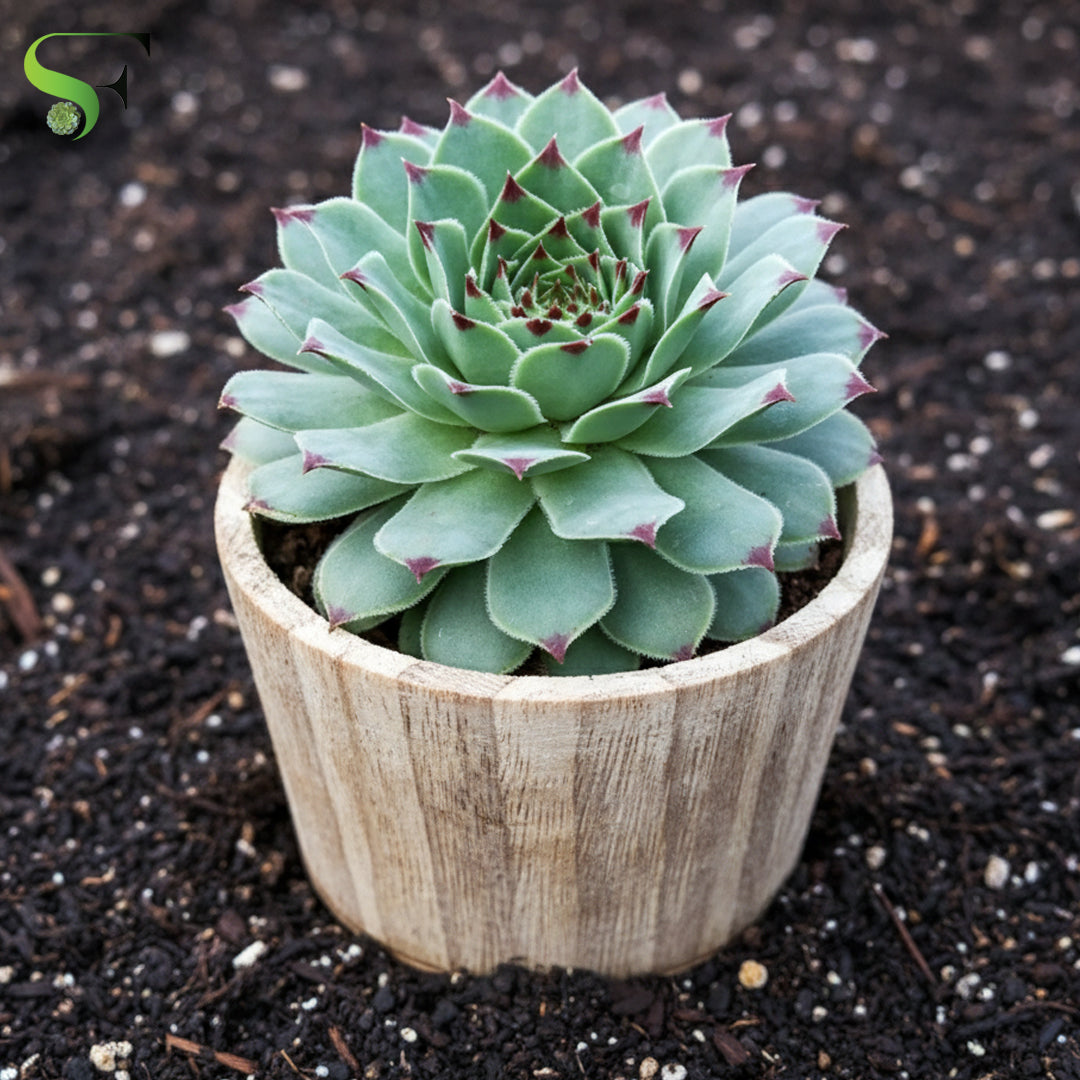Sempervivum 'Red Beauty' (Hens & Chicks) - S19
Sempervivum 'Red Beauty' (Hens & Chicks) - S19
Couldn't load pickup availability
ALL THE PLANTS WILL BE SENT BAREROOTED. NO POTS. NO SOIL
Sempervivum 'Red Beauty' is a highly sought-after cultivar of Sempervivum, known for its striking coloration and classic "Hens and Chicks" growth habit. It's a fantastic choice for adding vibrant color and texture to various garden settings.
Here are the details about Sempervivum 'Red Beauty':
Key Characteristics:
- Foliage Color: True to its name, 'Red Beauty' boasts rosettes with a beautiful play of colors. The base of the leaves is typically a gray-green or light green, while the pointed tips develop a deep, rich scarlet or burgundy red. This red coloration intensifies significantly in cooler weather, full sun, and with some stress (like dry conditions), making it a standout during autumn and winter.
- Rosette Size: The individual "hen" rosettes are medium-sized, typically growing to about 3-4 inches (7-10 cm) in diameter.
- Growth Habit: It forms dense, symmetrical rosettes and spreads readily by producing numerous "chicks" (offsets) on stolons around the base of the mother plant. This creates a charming, clumping mat over time.
- Flowers: In mid-summer, mature "hen" rosettes will send up a central flower stalk bearing clusters of star-shaped, soft pink blooms. Remember, like all Sempervivums, the rosette that flowers is monocarpic and will die after blooming, but the offsets will ensure the plant's continuity.
- Hardiness: 'Red Beauty' is incredibly hardy, typically thriving in USDA Zones 3-9. This means it can withstand very cold temperatures (down to -40°F or -40°C), making it suitable for a wide range of climates.
- Texture: The leaves are fleshy and succulent, forming a tight, geometric pattern. Some sources mention a "frosty tone" or "rippling watermarks of natural wax" on the leaves, adding to its visual appeal.
- Deer and Rabbit Resistant: It's generally not appealing to deer and rabbits, which is a plus for many gardeners.
Care and Tips for Sempervivum 'Red Beauty':
The care for 'Red Beauty' largely follows the general Sempervivum guidelines, emphasizing drainage and sunlight to achieve its best color.
-
Light:
- Full Sun is Ideal: To achieve the most intense red and burgundy coloration, plant 'Red Beauty' in a location that receives at least 6 hours of direct sunlight daily. The more sun, the better the color.
- Partial Sun: It can tolerate some partial shade, especially in very hot climates where afternoon shade might prevent scorching. However, too much shade will result in greener rosettes and less vibrant red tips.
-
Soil:
- Excellent Drainage: This is paramount. Use a gritty, well-draining soil mix specifically formulated for succulents or cacti. If planting in garden beds, amend heavy clay soils with plenty of coarse sand, perlite, pumice, or small gravel to ensure sharp drainage.
- Poor Soil Tolerant: 'Red Beauty' thrives in lean, even rocky or sandy soils, so rich, fertile soil is not necessary and can even be detrimental.
-
Watering:
- Drought Tolerant: Once established, 'Red Beauty' is highly drought-tolerant.
- Allow to Dry Completely: Water thoroughly but infrequently. Allow the soil to dry out completely between waterings. Overwatering is the most common cause of Sempervivum demise.
- Reduce in Winter: Significantly reduce watering during cooler, dormant months. Outdoor plants in areas with winter rainfall may require no additional watering.
-
Temperature and Humidity:
- Cold Hardy: Its exceptional cold hardiness makes it a reliable choice for cold winter climates.
- Good Airflow: Ensure good air circulation, especially when grown in containers or in humid environments, to prevent fungal issues.
-
Fertilizer:
- Rarely Needed: 'Red Beauty' generally doesn't require fertilizer.
- Very Light Feeding (Optional): If you feel the need, a very diluted, low-nitrogen succulent fertilizer can be applied once in spring at the beginning of the growing season. Over-fertilizing can lead to leggy growth and duller colors.
-
Potting and Repotting:
- Drainage Holes Essential: Always use containers with drainage holes. Terracotta pots are excellent for their breathability.
- Repotting: Repot every 1-2 years if the plant has become overcrowded with chicks, or if the soil is no longer draining well. This is also a good opportunity to separate and propagate the offsets.
-
Propagation:
- Offsets (Chicks): The easiest way to propagate 'Red Beauty' is by separating the "chicks." Simply snip the stolon connecting the chick to the mother plant and plant the chick directly into well-draining soil. They root very easily.
-
Pests and Diseases:
- Generally Problem-Free: 'Red Beauty' is quite resistant to most pests and diseases.
- Root Rot: The primary concern is root or crown rot due to excessive moisture. Ensure excellent drainage and avoid overwatering.
- Occasional Pests: Rarely, mealybugs or aphids might appear, especially on indoor plants. Treat with horticultural oil or insecticidal soap if necessary.
Uses in the Garden:
'Sempervivum 'Red Beauty' is highly versatile and perfect for:
- Rock Gardens: Its ability to thrive in poor, rocky soil and its compact habit make it a natural fit for rock gardens.
- Alpine Troughs/Containers: Excellent for shallow containers, troughs, and dish gardens, where its symmetrical form and vibrant color can be appreciated up close.
- Edging and Borders: Creates a striking, low-maintenance border along paths or garden beds.
- Crevices: Can be tucked into cracks in stone walls or between pavers.
- Green Roofs: Its hardiness and shallow root system make it suitable for extensive green roof applications.
- Xeriscaping: A perfect choice for water-wise gardens due to its drought tolerance.
Sempervivum 'Red Beauty' is a highly rewarding plant that offers year-round visual interest with its changing hues and charming "Hens and Chicks" habit, all with minimal effort.
Propogation
Propogation
Plant Care Guide
Plant Care Guide
Merchandising tips
Merchandising tips
Share




